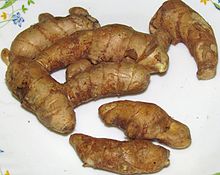Mango ginger
| Mango ginger | ||||||||||||
|---|---|---|---|---|---|---|---|---|---|---|---|---|

Mango ginger ( Curcuma amada ), illustration |
||||||||||||
| Systematics | ||||||||||||
|
||||||||||||
| Scientific name | ||||||||||||
| Curcuma amada | ||||||||||||
| Roxb. |
Mango ginger ( Curcuma amada ) is a species of the genus Curcuma within the ginger family (Zingiberaceae). Outwardly it is similar to ginger ( Zingiber officinale ), but has an aroma like the mango ( Mangifera indica ). It is widespread, cultivated and used in many ways in Asia.
description
Vegetative characteristics
Curcuma amada grows as a perennial herbaceous plant and it is similar to turmeric ( Curcuma longa ). It reaches heights of growth of about 80 to 115 centimeters. The pseudostem is formed from four to six leaves.
The creeping rhizome is relatively large and branched, with a sand-colored surface. Its inside is light to pale yellow and smells like green mango. The bulbs, which are divided in the shape of a hand, are thick, cylindrical and fleshy and arise from the base of the rhizome. There are hanging tubers.
With a length of up to 60 centimeters and a width of up to 15 centimeters, the relatively large, ribbed leaves are divided into a petiole and a leaf blade. The simple leaf blade is elongated-lanceolate with a pointed blade base and tip. The underside of the leaf is finely hairy and the upper side is sticky and smooth. The tip of the leaf has a mop of hair.
Generative characteristics
Laterally or rarely in the center of a long inflorescence stem is the spike-like inflorescence . The roof-tile-like (fertile) wrapper leaves are pale green or straw-colored. In the upper area of the inflorescence there are (sterile) bracts (coma); they are pale purple or pink in color. There are four to five flowers above the fertile bracts.
The relatively large, hermaphrodite flowers are zygomorphic and threefold with a double flower envelope . The bracts are yellowish. There is a fertile stamen and staminodes . Three carpels are fused to form a subordinate, three- chamber ovary. The long, filamentous stylus pushes between the stamen and the spurred anthers, the scar lies over it. There are two nectar glands .
The number of chromosomes is 2n = 40, 42 or 44.
distribution
Curcuma amada is found in India , Bangladesh , Myanmar and Thailand .
Taxonomy
The first description of Curcuma amada came in 1810 by William Roxburgh in Description of several of the Monandrous Plants of India belonging to the natural order called Scitamineae by Linnaeus; Cannae by Jussiue, and Drimyrhizae by Ventenat. in Asiatic Researches Volume 11, page 341. A synonym for Curcuma amada Roxb. 2009 is the heritage signed Curcuma amada var. glabra Velay. There is no such thing as a subtaxa .
Ingredients and usage
The rhizome contains at least 130 ingredients with biomedical relevance.
The fresh and dried rhizomes are used as a mild spice or vegetable in the kitchen. They are used in perfumery. Medical applications are known. As a cut flower, Curcuma amada has a long shelf life .
literature
- Rudragoud Policegoudra: Curcuma amada (Mango ginger): A potential medicinal plant: Bioactive properties of Curcuma amada. LAP Lambert Academic Publishing, 2012, ISBN 978-3-8484-1304-1 .
- PN Ravindran, K. Nirmal Babu, Kandaswamy Sivaraman: Turmeric: The genus Curcuma. CRC Press, 2007, ISBN 978-1-4200-0632-2 , pp. 18-20 ( Curcuma amada pages 18-20 in the Google book search).
- PN Ravindran: The Encyclopedia of Herbs and Spices. tape 2 . CABI, 2017, ISBN 978-1-78064-315-1 , pp. 605 ff . ( Curcuma amada from page 605 in the Google book search).
Web links
Individual evidence
- ↑ Shakeel A. Jatoi, Afsheen Zehra, Kazuo Watanabe: Morpho-Agronomic Characterization and Genetic Variability Aaaessment in Mango-Ginger (Curcuma amada; Zingiberaceae). In: Gomal University Journal of Research. Volume 31, Issue 2, 2015.
- ↑ a b data sheet from India Biodiversity , last accessed on November 12, 2018.
- ↑ a b c d Shakeel Ahmad Jatoi, Akira Kikuchi, Syed Abdullah Gilani, Kazuo N. Watanabe: Phytochemical, pharmacological and ethnobotanical studies in mango ginger (Curcuma amada Roxb .; Zingiberaceae). In: Phytotherapy Research . tape 21 , 2007, p. 507-516 , doi : 10.1002 / ptr.2137 .
- ↑ Curcuma amada at Tropicos.org. In: IPCN Chromosome Reports . Missouri Botanical Garden, St. Louis
- ↑ a b Rafaël Govaerts (Ed.): Curcuma amada. In: World Checklist of Selected Plant Families (WCSP) - The Board of Trustees of the Royal Botanic Gardens, Kew . Retrieved November 11, 2018.
- ↑ Curcuma amada at Tropicos.org. Missouri Botanical Garden, St. Louis, accessed on November 11, 2018.
- ^ A b ScienceDirect: PN Ravindran, M. Divakaran: KV Peter (Ed.): Handbook of Herbs and Spices. , Volume 2, Woodhead Publishing Series in Food Science, Technology and Nutrition, 2012, ISBN 978-0-85709-040-9 and KK Sinha: Spices and Flavoring (Flavoring) Crops | Tubers and Roots. In: Encyclopedia of Food Sciences and Nutrition , 2nd Edition, 2003 and KP Prabhakaran Nair: The Ornamental Curcuma. In: The Agronomy and Economy of Turmeric and Ginger , 2013 online at ScienceDirect , last accessed on November 12, 2018.
- ↑ a b Curcuma amada at Useful Tropical Plants , last accessed on November 11, 2018.
further reading
- Rudragoud Policegoudra, SM Aradhya: Mango ginger (Curcuma amada Roxb.) - A promising spice for phytochemicals and biological activities. In: Journal of Biosciences , Volume 36, Issue 4, 2011, pp. 739-748. doi : 10.1007 / s12038-011-9106-1
